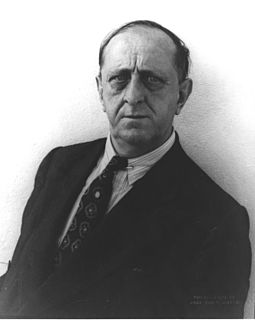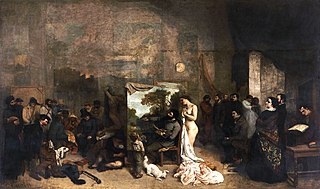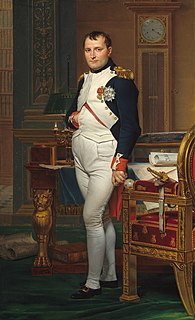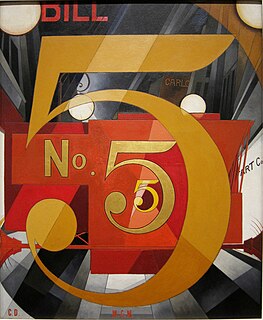
Charles Henry Buckius Demuth was an American painter who specialized in watercolors and turned to oils late in his career, developing a style of painting known as Precisionism.

Madonna and Child was painted by one of the most influential artists of the late 13th and early 14th century, Duccio di Buoninsegna. This iconic image of the Madonna and Child, seen throughout the history of western art, holds significant value in terms of stylistic innovations of religious subject matter that would continue to evolve for centuries.

Marsden Hartley was an American Modernist painter, poet, and essayist. Hartley developed his painting abilities by observing Cubist artists in Paris and Berlin.

Mughal painting is a style of painting on paper confined to miniatures either as book illustrations or as single works to be kept in albums (muraqqa), from the territory of the Mughal Empire in South Asia. It emerged from Persian miniature painting and developed in the court of the Mughal Empire of the 16th to 18th centuries. Battles, legendary stories, hunting scenes, wildlife, royal life, mythology, as well as other subjects have all been frequently depicted in paintings.

The Loves of the Gods is a monumental fresco cycle, completed by the Bolognese artist Annibale Carracci and his studio, in the Farnese Gallery which is located in the west wing of the Palazzo Farnese, now the French Embassy, in Rome. The frescoes were greatly admired at the time, and were later considered to reflect a significant change in painting style away from sixteenth century Mannerism in anticipation of the development of Baroque and Classicism in Rome during the seventeenth century.

Portrait Painting is a genre in painting, where the intent is to represent a specific human subject. The term 'portrait painting' can also describe the actual painted portrait. Portraitists may create their work by commission, for public and private persons, or they may be inspired by admiration or affection for the subject. Portraits often serve as important state and family records, as well as remembrances.

The Pompeian Styles are four periods which are distinguished in ancient Roman mural painting. They were originally delineated and described by the German archaeologist August Mau (1840–1909) from the excavation of wall paintings at Pompeii, which is one of the largest group of surviving examples of Roman frescoes.

The Painter's Studio: A real allegory summing up seven years of my artistic and moral life is an 1855 oil on canvas painting by Gustave Courbet. It is located in the Musée d'Orsay in Paris, France.

Aristotle with a Bust of Homer, also known as Aristotle Contemplating a Bust of Homer, is an oil-on-canvas painting by Rembrandt that depicts Aristotle wearing a gold chain and contemplating a sculpted bust of Homer. It was created as a commission for Don Antonio Ruffo's collection. It was bought and sold by several collectors until it was eventually purchased by the Metropolitan Museum of Art. The mysterious tone in the painting has led several scholars to different interpretations of Rembrandt's theme.

The Emperor Napoleon in His Study at the Tuileries is an 1812 painting by Jacques-Louis David. It shows French Emperor Napoleon I in uniform in his study at the Tuileries Palace. Despite the detail, it is unlikely that Napoleon posed for the portrait.

Arnold Rönnebeck was a German-born American modernist artist and museum administrator. He was a vital member of both the European and American avant-garde movements of the early twentieth century before settling in Denver, Colorado. Rönnebeck was a sculptor and painter, but is best known for his lithographs that featured a range of subjects including New York cityscapes, New Mexico and Colorado landscapes and Native American dances.

Self Portrait is an oil on canvas painting by the Dutch artist Rembrandt. Painted in 1652, it is one of over 40 painted self-portraits by Rembrandt, and was the first he had painted since 1645. In composition it is different from his previous self-portraits, depicting the painter in a direct frontal pose, hands on his hips, and with an air of self-confidence. It was painted the year that his financial difficulties began, and breaks with the sumptuous finery he had worn in previous self-portraits. Art historian Christopher White has called it "one of the most magisterial and sombre of these (late) pictures". It is in the Kunsthistorisches Museum in Vienna.

I Saw the Figure 5 in Gold, also known as The Figure 5 in Gold, is a 1928 painting by American artist Charles Demuth. It has been described as influenced by Futurism and Cubism.

Vertumnus is an oil painting produced by Giuseppe Arcimboldo in 1591 that consists of multiple fruits, vegetables and flowers that come together to create a portrait of Holy Roman Emperor Rudolf II. Although Arcimboldo's colleagues commented that Vertumnus was scherzo, or humorous, there were intentional political meanings behind the piece, particularly regarding the choice of fruits, vegetables, and flowers. Arcimboldo's choice to include these items was also an intentional reference to the Roman god, Vertumnus.

Guidoriccio da Fogliano at the Siege of Montemassi is a fresco on the western wall of the Sala del Mappamondo in the Palazzo Pubblico in Siena. It shows Guidoriccio da Fogliano, the commander of the Sienese troops, on horseback against the background of a landscape in which the siege of Montemassi takes place..

Arab Woman is a watercolor painting by American artist John Singer Sargent. Completed in either the late 19th or early 20th century, the painting is in the collection of the Metropolitan Museum of Art, in New York.

Bermuda No. 2, The Schooner is an early 20th century drawing by American artist Charles Demuth. Done in watercolor and graphite on paper, the work depicts the ship Danish ship Elsa. The drawing is in the collection of the Metropolitan Museum of Art.

Cemetery, New Mexico is an early 20th century painting by American artist Marsden Hartley. Done in oil on canvas, the painting depicts a cemetery in Taos Pueblo, New Mexico. The work is in the collection of the Metropolitan Museum of Art.

Lobster Fishermen is an early 20th century painting by American artist Marsden Hartley. Done in oil on masonite, the work depicts a group of lobster fishermen in Hartley's native state of Maine. Considered part of Hartley's 'Maine Series', Lobster Fishermen is in the collection of the Metropolitan Museum of Art.

Self-Portrait is a small oil on panel painting by Sofonisba Anguissola, signed and dated 1554 on the open book held by the artist. It is now in the Kunsthistorisches Museum in Vienna.




















